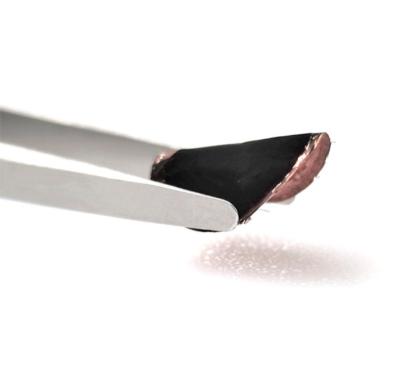Researchers from Carnegie Mellon University and MIT have demonstrated a 3D graphene-nanowire “sandwich” thermal interface that enables an ultralow thermal resistance of ∼0.24 mm2·K/W that is about 1 order of magnitude smaller than those of solders and several orders of magnitude lower than those of thermal greases, gels, and epoxies.
In addition, the new 3D graphene-nanowire “sandwich” thermal interface also boasts a low elastic and shear moduli of ∼1 MPa like polymers and foams. It exhibits excellent long-term reliability with >1000 cycles over a broad temperature range from −55 °C to 125 °C. This nanostructured thermal interface material can greatly benefit a variety of electronic systems and devices by allowing them to operate at lower temperatures or at the same temperature but with higher performance and higher power density.
“At first glance, our solution looks like any ordinary copper film, but under a microscope the novelty of our material becomes clear,” explained Lin Jing, Ph.D. student at Carnegie Mellon University and author of the new study.
The material, composed of two thin copper films with a graphene-coated copper nanowire array sandwiched between them, is extremely user-friendly.
“Other nanowires need to be in-situ grown where the heat is designed to be dissipated, so that their application threshold and cost is high,” said Rui Cheng, postdoctoral researcher in Sheng Shen's lab. “Our film isn’t dependent on any substrate; it is a free-standing film that can be cut to any size or shape to fill the gap between various electrical components.”
The “sandwich” builds out of Shen’s “supersolder,” a thermal interface material (TIM) that can be used similarly as conventional solders, but with twice the thermal conductance of current state-of-the-art TIMs.
By coating the “supersolder” in graphene, Shen’s team enhanced its thermal transport capabilities and prevented the risk of oxidation, ensuring a longer service life.
The “sandwich,” compared to the thermal pastes/adhesives currently on the market, can reduce thermal resistance by more than 90% when considering the same thickness. Thanks to its ultra-high mechanical flexibility, the “sandwich” can enable a wide range of applications in flexible electronics and microelectronics, including flexible LEDs and lasers for lighting and display, wearable sensors for communication, implantable electronics for monitoring health and imaging, and soft robotics.
Moving forward, the team will explore ways to scale the material at an industrial level and lower its cost, while continuing to seek ways to improve it. “We are very excited about this material’s potential,” Shen shared. “We believe that a wide variety of electronic systems can benefit from it by allowing them to operate at a lower temperature with higher performance.”
